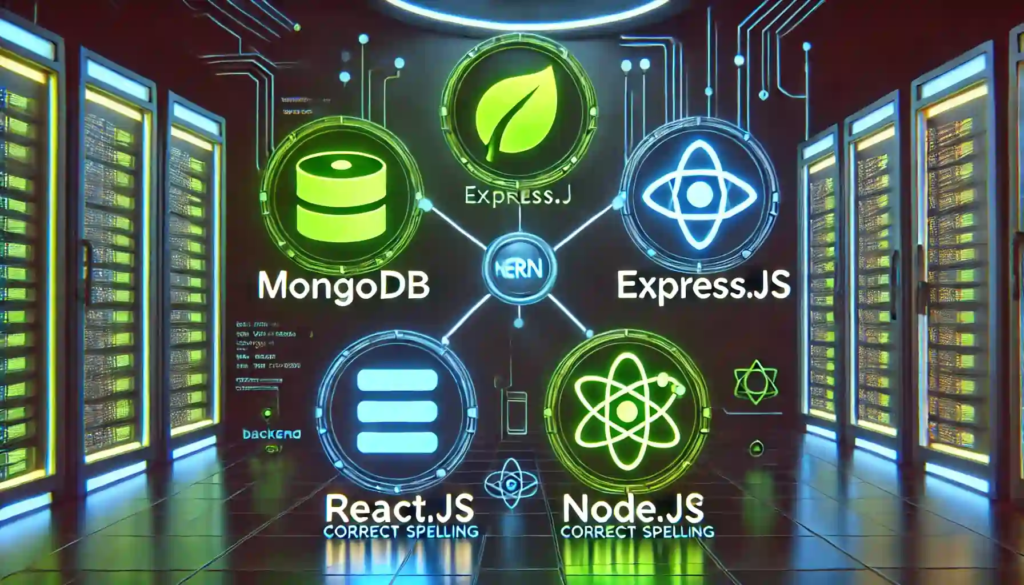Brief Explanation of Full-Stack Development
Full-stack development involves building both the frontend (client-side) and backend (server-side) of web applications. A full-stack developer works with databases, servers, APIs, and user interfaces. The MERN Stack is one of the most popular full-stack frameworks because it uses JavaScript across all layers, making development seamless and efficient.
What is the MERN Stack?
The MERN Stack is a combination of four powerful technologies:
- MongoDB – A NoSQL database for storing data
- Express.js – A backend framework for Node.js
- React.js – A frontend library for building dynamic user interfaces
- Node.js – A JavaScript runtime for server-side execution
This stack allows developers to build end-to-end web applications using just one programming language: JavaScript.
Why is the MERN Stack Popular?
The MERN Stack has gained immense popularity due to:
- Single Language Efficiency – JavaScript is used throughout the stack.
- High Performance – React’s virtual DOM and Node’s non-blocking I/O enhance speed.
- Scalability – MongoDB’s flexible schema supports growing applications.
- Strong Community & Job Demand – Companies prefer MERN for modern web apps.
Breakdown of the MERN Stack Components
1. MongoDB: NoSQL Database & Its Advantages
MongoDB is a document-based NoSQL database that stores data in JSON-like formats (BSON). Key benefits include:
- Schema Flexibility – No rigid structure, allowing easy modifications.
- Scalability – Handles large datasets with horizontal scaling (sharding).
- High Performance – Indexing and in-memory processing improve speed.
- Cloud Integration – Works seamlessly with MongoDB Atlas (cloud database service).
2. Express.js: Backend Framework for Node.js
Express.js is a minimalist backend framework that simplifies server-side development with:
- Routing – Handles HTTP requests (GET, POST, PUT, DELETE).
- Middleware Support – Enhances functionality (authentication, logging).
- Fast Development – Reduces boilerplate code for APIs.
- Integration with Node.js – Works efficiently with the Node.js runtime.
3. React.js: Frontend Library for UI Development
React.js, developed by Facebook, is a component-based library for building interactive UIs. Key features:
- Virtual DOM – Optimizes rendering for better performance.
- Reusable Components – Saves development time.
- State Management – Libraries like Redux and Context API manage data flow.
- Strong Ecosystem – Supports tools like Next.js for SSR (Server-Side Rendering).
4. Node.js: JavaScript Runtime for Server-Side Execution
Node.js allows JavaScript to run outside the browser (on the server). Advantages include:
- Non-Blocking I/O – Handles multiple requests efficiently.
- NPM (Node Package Manager) – Access to thousands of libraries.
- Real-Time Capabilities – Ideal for chat apps, gaming, and live updates.
- Cross-Platform Support – Runs on Windows, Linux, and macOS.
How the MERN Stack Works Together
Flow of Data (Client → Server → Database)
- Frontend (React.js) – The user interacts with the React-based UI.
- Backend (Express.js & Node.js) – Handles API requests and business logic.
- Database (MongoDB) – Stores and retrieves data in JSON format.
RESTful APIs & JSON Communication
- The frontend (React) sends HTTP requests to the backend (Express).
- The backend processes requests, interacts with MongoDB, and sends JSON responses.
- React then dynamically updates the UI based on the received data.
Single Language (JavaScript) Advantage
- Consistency – Developers use JavaScript for both frontend and backend.
- Faster Development – No need to switch between languages like PHP or Python.
- Easier Debugging – Unified language simplifies troubleshooting.
Benefits of Learning the MERN Stack
1. Full-Stack Development with One Language (JavaScript)
- Learn one language to build entire applications.
- Reduces learning curve compared to stacks like LAMP (PHP) or MEAN (TypeScript).
2. High Performance & Scalability
- React’s Virtual DOM ensures fast rendering.
- Node.js handles thousands of concurrent connections.
- MongoDB scales horizontally for large applications.
3. Strong Community & Job Market Demand
- High-paying jobs for MERN developers (LinkedIn, Indeed, Glassdoor).
- Open-source support with constant updates and improvements.
4. Rich Ecosystem (Libraries, Tools, and Frameworks)
- Frontend: Redux, Material-UI, Next.js
- Backend: Mongoose (ODM for MongoDB), JWT (Authentication)
- DevOps: Docker, AWS, Heroku for deployment
Real-World Applications of MERN
Companies Using MERN
- Netflix (Uses React for UI)
- Facebook (Built React for their platform)
- Instagram (Leverages React and Node.js)
Types of Projects Built with MERN
- Single-Page Applications (SPAs) – Social media dashboards
- E-commerce Platforms – Dynamic product listings
- Real-Time Apps – Chat applications, live tracking
How to Get Started with MERN
Prerequisites
- Basic HTML, CSS, JavaScript knowledge
- Understanding of ES6+ features
Recommended Learning Path
- Learn JavaScript Fundamentals
- Master React.js (Components, State, Hooks)
- Explore Node.js & Express.js (Build REST APIs)
- Integrate MongoDB (CRUD Operations)
Free & Paid Resources
- Free: MDN Web Docs, freeCodeCamp, The Odin Project
- Paid: Udemy, Coursera, Pluralsight
Conclusion
The MERN Stack is a highly effective, sought-after framework for building full-stack applications. With JavaScript at its core, it offers seamless integration, high performance, and scalability. Whether you’re a beginner or an experienced developer, learning the MERN Stack opens doors to lucrative job opportunities and the ability to build cutting-edge web applications.
Start learning the MERN Stack today and future-proof your development career! 🚀




